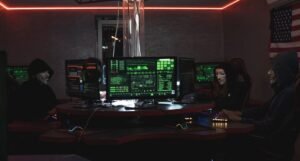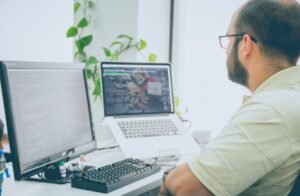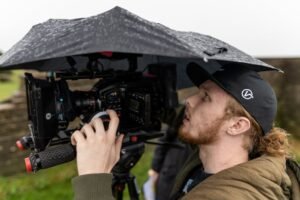Top AI Art Programs
Artificial intelligence (AI) has become an increasingly prominent technology in the world of art. AI art programs are revolutionizing the creative process and enabling artists to produce stunning artworks with the help of machine learning algorithms. In this article, we will explore some of the top AI art programs currently available, highlighting their features, benefits, and how they are shaping the future of artistic expression.
Key Takeaways:
- AI art programs utilize machine learning algorithms to help artists produce innovative and unique artworks.
- These programs provide a range of features, including style transfer, image generation, and interactive painting.
- AI art programs can enhance an artist’s creative workflow and offer new tools for exploration and experimentation.
- There are both standalone AI art software and online platforms available, catering to different artistic needs and preferences.
One of the most popular AI art programs is DeepArt.io. This online platform allows users to transform their photos into artworks inspired by famous artists and art styles. Using a deep neural network, DeepArt.io analyzes the content and style of an image, producing a visually stunning combination. *This program has gained popularity among artists and art enthusiasts due to its ability to create unique and artistic interpretations of photographs.*
Style Transfer and Image Generation
AI art programs often offer features such as style transfer and image generation. Style transfer allows artists to apply the characteristics of specific artworks or artistic styles to their own creations. By analyzing the style and content of an artwork, the program can transfer those elements to a new image, creating a fusion between different artistic approaches. *This technique enables artists to explore new aesthetics and experiment with various visual styles.*
Another popular AI art program is Runway ML. It provides an intuitive interface and a wide range of AI models specifically designed for artists. With Runway ML, artists can experiment with style transfer, create generative art, perform interactive painting, and even train their own custom models. *This program empowers artists to explore and push the boundaries of what is possible in the realm of AI-generated art.*
Interactive Painting and Collaborative Art
In addition to style transfer and image generation, AI art programs can also facilitate interactive painting and collaborative art projects. These programs often utilize techniques such as generative adversarial networks (GANs) to enable users to create art in real-time and collaborate with AI systems. Artists can interact with AI models, influencing the generation process and creating unique and unpredictable outcomes. *This interactive nature of AI art programs opens up new possibilities for artistic expression and collaboration between humans and machines.*
One example of an AI art program that focuses on interactive painting is Google’s DeepDream. Using deep neural networks, DeepDream allows artists to create dream-like and abstract visuals by applying algorithms that emphasize patterns and textures within images. *This program has gained popularity for its ability to create surreal and visually captivating paintings, often producing unexpected and mesmerizing results.*
AI Art Programs: Standalone Software and Online Platforms
AI art programs can be found as standalone software or online platforms. Standalone software is typically more powerful, providing advanced features and customization options. These programs often require more technical expertise but offer greater flexibility for artists who want to dive deep into AI-powered art creation. Online platforms, on the other hand, are more accessible and user-friendly, allowing artists to create AI-generated art without the need for extensive technical knowledge. *This variety of options ensures that artists of all skill levels can find an AI art program that suits their needs and preferences.*
To further highlight the different features of AI art programs, we present three tables showcasing some popular programs, their key features, and their compatibility:
| AI Art Program | Key Features | Compatibility |
|---|---|---|
| DeepArt.io | Style transfer, famous artist filters, neural network algorithms | Online platform, compatible with various devices and operating systems |
| Runway ML | Style transfer, generative art, interactive painting, custom model training | Standalone software, compatible with macOS and Windows |
| DeepDream | Interactive painting, deep neural networks, emphasis on patterns and textures | Online platform, compatible with various devices and operating systems |
AI art programs continue to push the boundaries of artistic expression, providing artists with new tools and creative possibilities. Whether it is through style transfer, image generation, interactive painting, or collaborative art, these programs offer unique avenues for artists to explore and experiment with their craft. By combining human creativity with the power of AI algorithms, AI art programs are shaping the future of the art world, fostering innovation, and expanding artistic horizons. *Through these programs, artists can delve into the exciting realm of AI art and unlock new dimensions of their creative journey.*

Common Misconceptions
Misconception 1: AI art programs can only generate basic art
One common misconception about AI art programs is that they can only produce simple or basic art. While AI technology was initially limited in its ability to create complex and intricate artwork, recent advancements have led to the development of highly sophisticated AI art programs that can generate stunning pieces of art.
- AI art programs can create intricate and detailed artwork
- They can generate realistic and lifelike images
- AI art programs can produce art in various styles and genres
Misconception 2: AI art programs replace human artists
Another common misconception is that AI art programs are meant to replace human artists. This is not entirely true. While AI can assist and enhance the creative process, it cannot replace the unique perspective, emotions, and creativity that humans bring to art.
- AI art programs can be used as a tool by artists to explore new techniques and styles
- They can speed up the process of creating art but cannot replace the artist’s vision
- AI art programs can inspire and influence artists, but human interpretation is still crucial
Misconception 3: AI art programs lack originality
Some people believe that AI art programs lack originality, as they rely on algorithms and pre-existing data to create art. However, AI can generate unique and innovative artwork by combining and reinterpreting existing ideas or styles.
- AI art programs can remix and combine different artistic styles to create something new
- They can introduce novel interpretations and perspectives to art
- AI art programs can produce art that challenges traditional notions of creativity
Misconception 4: AI art programs don’t require any human input
Contrary to popular belief, AI art programs do require human input and guidance. Artists need to provide initial direction, input, and control the parameters of the AI system to achieve the desired results.
- Human artists have to define the style, subject, and concept for the AI art program
- Artists need to curate and select the training data that the AI program uses
- Human input is necessary to refine and iterate on the generated art output
Misconception 5: AI art programs are a threat to the art industry
Many people fear that AI art programs will lead to a decline in the art industry or make human artists obsolete. However, AI can be seen as a valuable tool that enriches the creative process and expands the possibilities of what can be achieved in art.
- AI art programs can open new avenues for artists to explore and experiment
- They can bring more accessibility to art creation and appreciation
- AI can enhance collaboration between human artists and AI systems

AI Art Programs by Company
Below is a list of top AI art programs developed by various companies. These programs utilize artificial intelligence to create stunning and unique artistic pieces.
| Company | Program Name |
|---|---|
| OpenAI | GPT-3 Art Generator |
| Adobe | Adobe Sensei |
| DeepDream | |
| IBM | Watson Art |
| Microsoft | Microsoft AI Creativity |
AI Art Programs by Art Style
Artificial intelligence can mimic various art styles, allowing users to generate artwork in a specific aesthetic. The table below presents top AI art programs categorized by art style.
| Art Style | Program Name |
|---|---|
| Impressionism | Impressionism AI |
| Cubism | Cubism Master |
| Abstract | Abstract Art AI |
| Pop Art | PopAI |
| Surrealism | SurrealArt |
AI Art Programs by Output Medium
AI art programs are not limited to creating digital artwork. They can also generate art in various other mediums. Check out the table below to explore top AI art programs based on their output medium.
| Output Medium | Program Name |
|---|---|
| Canvas Painting | e-Painter |
| Sculpture | AISculptor |
| Photography | PhotoAI |
| Digital Animation | AI Animator Pro |
| Textile Design | TextileArtGen |
AI-Generated Art and Its Impact
The rise of AI-generated art has revolutionized the artistic landscape, challenging our perceptions and pushing the boundaries of creativity. This table highlights various aspects of the impact of AI-generated art.
| Aspect | Impact |
|---|---|
| Accessibility | Democratizes art creation and appreciation |
| Innovation | Fosters new artistic techniques and styles |
| Criticism | Raises questions about authorship and originality |
| Inspiration | Provides inspiration and collaboration opportunities |
| Ethics | Raises ethical concerns about AI’s creative capabilities |
Popular AI Artists
Several artists have gained recognition for their use of AI in creating impressive artwork. The following table showcases some popular AI artists and their notable works.
| Artist | Notable Work |
|---|---|
| AICreativ | Digital Dreamscapes |
| PixelBot | Algorithmic Abstractions |
| DeepArt | Abyssal Visions |
| CodeBrush | Technicolor Transcendence |
| iGenius | Artistic Algorithms |
AI Art Achievements
Art created with the help of AI has achieved incredible milestones, from exhibitions to record-breaking sales. Explore some noteworthy AI art achievements in the table below.
| Achievement | Details |
|---|---|
| First AI Art Exhibition | “Technological Imagination” at the Museum of AI Art |
| Record-Breaking Auction | AI artwork sold for $69.3 million at Christie’s |
| Creative Partnerships | AI artists collaborating with renowned human artists |
| Public Recognition | AI-generated art featured in prominent galleries worldwide |
| Artistic Awards | AI artists honored with prestigious art prizes |
AI Art Programs for Education
AI art programs have found valuable applications in educational settings, encouraging creativity and facilitating learning. The table below presents AI art programs specifically designed for educational institutions.
| Program | Target Education Level |
|---|---|
| ArtBots Edu | Primary and Secondary Schools |
| AI-Arts Academy | Higher Education / University Level |
| ArtTech Kids | Early Childhood Education |
| School of AI Arts | Community Learning Centers |
| PixelPioneers | Online Art Courses |
The Future of AI Art
The development of AI art programs continues to advance, with exciting possibilities for the future. This table outlines some potential advancements and directions in the field of AI-generated art.
| Potential Advancement | Description |
|---|---|
| Collaborative AI Artists | AI collaborating with multiple artists in real-time |
| Emotional Expression | AI-generated art evoking complex emotions in viewers |
| Interactive Art Experiences | AI art installations responding to viewer interactions |
| AI Art Therapy | Using AI-generated art for therapeutic purposes |
| Artificial Artistic Intuition | AI developing its own unique artistic style and intuition |
The world of AI-generated art continues to captivate and amaze us with its limitless possibilities. Through innovative AI art programs, artists can explore new creative dimensions and push artistic boundaries. From democratizing art creation to fostering collaborations, the impact of AI in the art world is undeniable. As we move forward, exciting advancements and unexplored territories await, inviting us to witness the remarkable evolution of AI-generated art.
Frequently Asked Questions
FAQs about Top AI Art Programs
What are AI art programs?
AI art programs are software applications that utilize artificial intelligence algorithms to create or assist in the creation of artworks. They typically employ techniques like machine learning and neural networks to analyze and generate unique visual outputs.
What are the advantages of using AI art programs?
Using AI art programs can offer several advantages. They enable artists to explore innovative techniques and styles, automate certain time-consuming tasks, provide creative inspiration, and facilitate experimentation with different artistic elements. Additionally, these programs often learn from user interactions and improve over time.
Can AI art programs replace human artists?
No, AI art programs cannot replace human artists. While AI can generate interesting and unique visual outputs, it lacks the depth of creativity, emotions, and intuitive decision-making that humans possess. AI art programs should be seen as tools that complement and augment human creativity rather than replace it.
Are AI art programs suitable for beginners?
Yes, AI art programs can be suitable for beginners. Many of these programs come with user-friendly interfaces and tutorials that help beginners get started. They may offer guided assistance, preset styles, and easy-to-use tools that aid in the creation of art even for those with limited experience or technical skills.
Do AI art programs require coding knowledge?
It depends on the specific AI art program. Some programs may require coding knowledge to customize or extend their functionalities. However, many AI art programs are designed to be accessible to users without coding experience, offering visual interfaces and intuitive controls.
Can AI art programs generate original artworks?
Yes, AI art programs are capable of generating original artworks. Through training on large datasets and their ability to learn from patterns and visual styles, AI algorithms can create never-before-seen artworks that mimic or explore various artistic styles, subject matters, and compositions.
What types of art can be created using AI art programs?
AI art programs can be used to create a wide range of visual art, including paintings, illustrations, digital art, sculptures, and even interactive installations. The possibilities are vast, and artists can experiment with different styles, textures, color palettes, and visual effects.
Are AI art programs only used by individual artists?
No, AI art programs are also used by institutions, organizations, and creative agencies. They offer benefits to individual artists, but they can also be utilized in commercial projects, marketing campaigns, and multimedia productions where automated or AI-enhanced art creation is desired.
Are there any legal considerations when using AI art programs?
Yes, when using AI art programs, it is crucial to consider legal aspects such as intellectual property rights and copyright. Some AI art programs may utilize pre-existing artworks or rely on trained models that have been created using copyrighted material. It is important to ensure proper licensing or use resources that are copyright-free.
What are some popular AI art programs available today?
There are several popular AI art programs available today, including DeepArt, Prisma, DeepDream, Runway ML, ArtBreeder, and StyleGAN. Each program offers unique features, interfaces, and artistic possibilities, allowing users to experiment and explore AI-powered artistic techniques.




